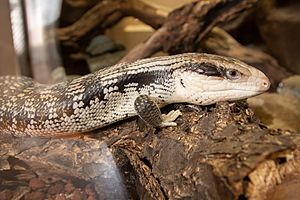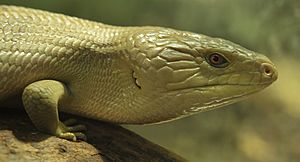Eastern blue-tongued lizard facts for kids
Quick facts for kids Eastern blue-tongued skink |
|
|---|---|
 |
|
| Scientific classification |
|
| Kingdom: | Animalia |
| Phylum: | Chordata |
| Class: | Reptilia |
| Order: | Squamata |
| Family: | Scincidae |
| Genus: | Tiliqua |
| Species: | |
| Subspecies: |
T. s. scincoides
|
| Trinomial name | |
| Tiliqua scincoides scincoides (White, 1790)
|
|
The eastern blue-tongued lizard (Tiliqua scincoides scincoides) is a type of large skink. It is very common in eastern Australia. You can often find it in bushland (wild areas with shrubs) and even in suburban areas (places where people live). It gets its name "blue-tongue" because its tongue is bright blue! When this lizard feels scared, it shows its blue tongue and makes a loud hissing sound.
Contents
About the Eastern Blue-Tongued Skink
This lizard is quite chunky and moves slowly. It has scales that are brown to grey. You can see stripes or bars across its body and tail. Its belly is usually a pale color.
Where Do They Live?
Eastern blue-tongued skinks live in many parts of eastern Australia. They like places where they can find good shelter and food. This includes forests, woodlands, and even gardens in towns. They often hide under logs, rocks, or thick bushes.
Life as a Blue-Tongued Skink
Blue-tongued lizards are popular as pets. They can live for a very long time, sometimes up to 30 years, when cared for by humans. Unlike many reptiles, these lizards give birth to live young. They do not lay eggs.
Baby Skinks
A mother blue-tongued skink can have between six and 20 babies at once. The babies are born inside a thin egg sac. They eat this sac right after they are born. Baby skinks look very much like tiny versions of their parents.
Other Blue-Tongued Lizards
There are several other kinds of blue-tongued lizards. They all belong to the same group called Tiliqua. Some examples include the northern blue-tongued skink. Another interesting one is the shingleback, also known as the stump-tailed skink. Each type has its own unique look and habits.
Who Discovered Them?
The eastern blue-tongued skink was first described by a person named John White. He was an Irish surgeon and botanist. He gave it the scientific name Lacerta scincoides in 1790.


